Ixora Chinensis Profile
Written by Lisa
Sep 18 2021
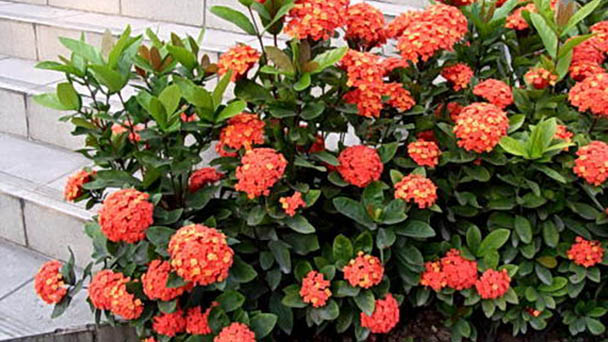
Ixora Chinensis is native to southern China and Malaysia. It was introduced to Britain at the end of the 17th century and then spread to European countries. The plants are low and short, the flowers and leaves are beautiful, and the flowers are rich in color. There are flowers to enjoy throughout the year, including red, orange, yellow, white, and double colors. It is planted in an open field in southern China, suitable for gardens, hotels, and scenic areas. It is scattered in heights, bright in color, and excellent in landscape effects. It is an important potted Rosa banksiae. Widely used in potted plants for viewing.
Ixora Chinensis Picture
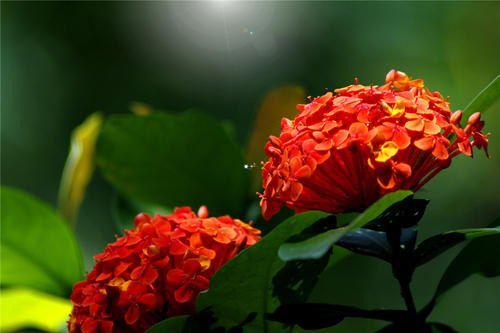
Ixora Chinensis Morphological Characteristics
Ixora Chinensis is shrubs, 0.8-2 meters high, glabrous; branchlets are dark brown and shiny at first, and gray with lines when old. The leaves of Ixora Chinensis are opposite, sometimes several into 4 whorls due to the extremely short internode distance, lanceolate, oblong-lanceolate to oblong-oblanceolate, 6-13 cm long, 3-4 cm wide, blunt or apex Round, short pointed or round at the base; midribs are flattened on the top and slightly concave, convex on the bottom, side veins are 7-8 on each side, slender, conspicuous, connected to each other near the leaf margin, transverse veins are loose and conspicuous; The petiole is very short and thick or absent; the stipules are 5-7 mm long, the base is broad, and connate into a sheath shape, the tip is long and acuminate, and the acuminate part is tapered, longer than the sheath. The inflorescence is terminal, multi-flowered, with a short total pedicel; the total pedicel is 5-15 mm long, and the branches are red, and it is rarely powdery pilose. The base often has 2 small leaves supporting; bracts and bracteoles Tiny, born in pairs at the base of the torus; flowers with pedicel or no; calyx tube 1.5-2 mm long, calyx eaves 4-lobed, lobes very short, 0.8 mm long, short pointed or obtuse; corolla red or reddish yellow, long in full bloom 2.5-3 cm, 4 lobed apex, lobes obovate or nearly round, extended or reversed, 5-7 mm long, 4-5 mm wide, blunt or round at the tip; filaments are extremely short, anthers are oblong, approximately in length 2 mm, 2-lobed at the base; style short protruding outside the crown tube, stigma 2, initially close together, diverging when blooming, slightly curved downward. The fruit is subglobose, twin, with a groove in the middle, red and black when mature; the Ixora Chinensis seed is long and 4-4.5 mm wide, convex on the top and concave on the bottom. It's flowering from May to July.
Ixora Chinensis Growth Habit
Ixora Chinensis is more suitable for high temperature and sufficient sunshine environment, like humid and hot
Ixora Chinensis is not resistant to low temperatures. The optimum temperature for growth is 23~32℃. When the temperature is lower than 20℃, its growth is weakened and the flowering is obviously reduced. However, if the sunshine is sufficient, there will still be a certain number of flower buds; when the temperature is lower than 10℃, its physiological activity will decrease, Growth is slow; when the temperature is lower than 0℃, it will produce freezing damage. Ixora Chinensis likes acidic soil, the most suitable soil pH is 5~5.5. Soil with good drainage and good fertility retention can grow well. The best cultivation soil is sandy loam or humus loam rich in organic matter. If the soil is alkalescent, the growth of Ixora Chinensiss will be blocked and the growth will be poor.
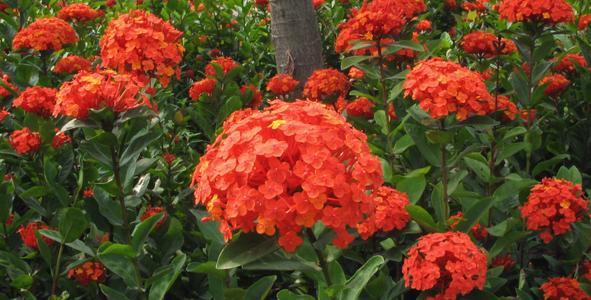
Ixora Chinensis Distribution
Ixora Chinensis is native to China, Myanmar and Malaysia. China is mainly distributed in Fujian, Guangdong, Hong Kong and Guangxi. There are also tropical areas such as Vietnam, the Philippines, Malaysia, and Indonesia.
Ixora Chinensis Propagation
Sowing, layering, and cuttings are acceptable for the propagation of Ixora Chinensis, but cuttings are generally used. It is better to proceed from June to July. Select semi-mature branches, 10~15 cm long, and insert them into the sand bed at a suitable temperature of 24~30℃, and take roots 40~50 days after insertion. The cuttings are soaked in 0.5% indole butyric acid solution for 3~5 seconds to shorten the rooting period
1. Environmental factors affecting rooting
The suitable bed temperature for Ixora Chinensis cutting hair roots is 25~35℃, and the temperature is slightly lower than the bed temperature, about 23~35℃; cutting time is best in spring and summer. Under normal circumstances, natural light can basically satisfy cuttings hair roots. Yes, but during the tropical summer high temperature period, since the cuttings are easy to wilt, it is best to use spray seedlings, and the cuttings should be shaded within a few days, from the initial 50% to 60% shading rate, and gradually reduce to 40% to 50%. After the hair roots, remove the shade.
2. Cuttings
The quality of cuttings not only affects the quality of Ixora Chinensis seedlings, but also affects the subsequent growth. For the requirements of good cuttings, the twig cuttings are cut in spring and summer. At this time, the plants have a lot of tender strips. Cut them when they grow to 8~12 cm and are not blooming. The time is the evening of the sky. Choose Growing vigorously and disease-free, the cuttings are neatly sized branches; cuttings generally have a fresh weight of 3 to 5 grams, a length of 10 to 14 cm, and a cutting diameter of 3 mm or more. The cutting position is semi-hardened branches, usually by cutting off side branches or Combine the main branches cut during strong pruning.
3. Processing of cuttings
The difficulty of rooting is different due to different Ixora Chinensis varieties. The dwarf varieties with small leaves are generally easy to root, and the cuttings do not need to be processed and can quickly and quickly root; but for the tall varieties with large leaves It is a variety that is difficult to root. The use of growth hormones such as indole butyric acid (IBA) or naphthalene acetic acid (NAA) before cutting can significantly promote rooting. For treatment, a low-concentration rooting promoter can be used for long-term soaking or high-concentration instant soaking.
4. Soil for cuttings
The correct selection of cutting soil has a great relationship with the rooting rate of cuttings and the rate of emergence from the nursery. The standards for cutting soil are water retention, strong permeability, and cleanliness. The substrates used for Ixora Chinensis cuttings include perlite, vermiculite, river sand, etc. The above materials can be used alone or mixed. River sand has good permeability, but poor water retention. Generally mixed with perlite, if used alone, it is suitable for Gap spray cuttings. Single perlite is suitable for summer in drought and strong sunshine. In Hainan, it is best to use a mixture of river sand and perlite in a ratio of 1:1, or use river sand as a base, and spread a layer of 2 to 3 cm thick perlite on the sand.
Ixora Chinensis Sowing Propagation
Ixora Chinensis Seeds are collected in winter and sown in spring. The suitable temperature for germination is 22~24℃, and it will germinate 20~25 days after sowing. When 3~4 pairs of true leaves are grown, the seedlings can be transferred to 8 cm pots.
Ixora Chinensis Layering Propagation
Ixora Chinensis Plants with many branches and dense, circular peeling at a distance of 20 cm from the top, wrapped with peat and film, can heal and take root in more than 2 months.
Ixora Chinensis Care
soil
The cultivating soil of Ixora Chinensis is preferably well-drained, acidic, organic-rich sandy loam or humus loam. Before transplanting, deep turn the soil layer to break up large soil masses. According to the soil structure, mix with river sand and organic manure soil thoroughly to reach the soil conditions suitable for the growth of Ixora Chinensiss; the nutrient soil for pot cutting or bag seedlings, then Mix 1 part of garden soil, 1 part of river sand, and 1 part of organic fertile soil, or prepare with pond mud, river sand, and coconut chaff in a ratio of 1:1:0.5.
Transplant
The cuttings should be transplanted after they are rooted. Generally, the roots should be removed from the cutting bed if the root length is less than 2 cm. If the root system is longer than 2 cm, the roots will be easily broken when the seedlings are taken, which will affect the slow rooting and initial growth of the seedlings. The pots with a diameter of 10 to 20 cm are commonly used in the cutting of Longchuan flower pots. It depends on the size of the seedlings and the number of plants to be cut. The plants in the pots must be neat and uniform in color. The pots are cut every 1 to 2 years, and the pots are changed once every 1 to 2 years, and trimmed to remove diseased and weak branches. Regardless of whether it is pot cutting or ground cutting, you must choose a sunny place. The ixora chinensis ground is cut into a shaped block and has a quick effect. Generally, you choose 1 to 3 years of pot seedlings or bag seedlings, which can be carried out all year round and planted in deep soil. The place. When indoor pot cutting of Ixora Chinensis in winter, it must be kept above 15℃ to continue to grow. If the temperature is too low, it will cause leaf fall.
Water and fertilizer
Ixora Chinensis are wet and afraid of dryness. The stems and leaves need sufficient water during the growth period to keep the pot soil moist, which is conducive to shoot germination and leaf growth. But long-term excessive humidity can easily cause part of the root system to rot and affect growth and flowering. If the soil is too dry or wet from time to time, and the water supply is not timely, leaf falling will occur.
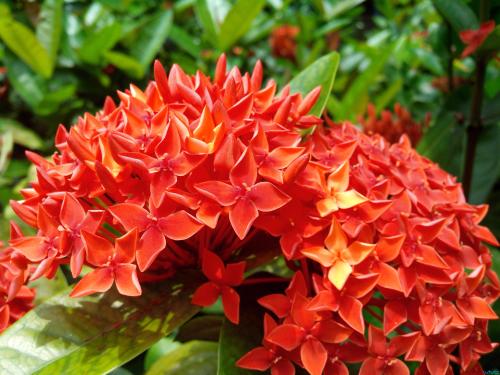
Spring, summer, and autumn are the growth and flowering periods of Ixora Chinensiss. Water and fertilizer management should be strengthened. Fertilization should be applied once every 30 to 40 days. Various organic fertilizers or inorganic compound fertilizers are ideal. For planting in northern areas, apply "Huiyou" 21-7-7 acid fertilizer once every half month. If the leaves are light green, become puddled and lack luster, have less flowering, and the flower color is lighter, it means that there is insufficient light, not a lack of fertilizer and water.
Ixora Chinensis Pest Control
Leaf Spot
The disease is caused by Fusarium spp. The pathogen overwinters on diseased flowers or falls on the soil with diseased leaves. It is spread by wind, rain or water in the next year.
Prevention method:
Horticulture control: meet the growth conditions of the Ixora Chinensis, warm and humid climate, and loose and fertile acid soil.
For the prevention and treatment of medicaments, start spraying at the beginning of the disease. The medicament can be 50% thiophanate-methyl·sulfur suspension 800 times liquid; or 50% carbendazim wettable powder 500 times liquid; or 10% antibacterial agent 401 acetic acid 1000 times liquid spray.
Anthrax
The disease mainly damages the leaves. The pathogen overwinters on the diseased part or the remains of the diseased leaf. When conditions are suitable, it is spread by wind and rain, and invades from the wound for the initial infection.
Prevention method:
Horticulture control: remove diseased leaves and reduce the source of infection. The flowerpots or plants are properly spaced to ensure good ventilation and light transmission.
Chemical control: spray before the onset of the disease, and the medicament can be 1:1:200 times Bordeaux liquid; or 50% carbendazim wettable powder plus 75% chlorothalonil wettable powder 800 times liquid; or 25% chartrane Wet powder 500 times liquid. The above-mentioned agent is sprayed once every 10 days or so, for 3 to 4 times of continuous control.
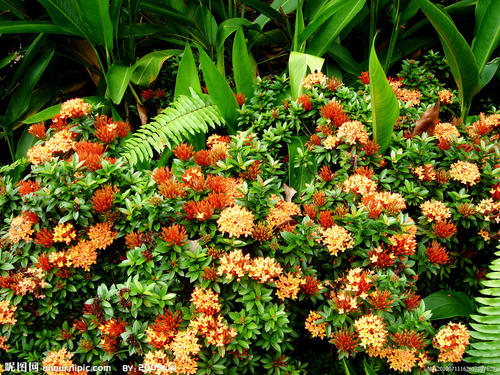
Scale insects
Once scale insects occur, the damage is great, and the main focus is on prevention. Once scale insects are found in Ixora Chinensis, they should be controlled in time without delay. Scale insects can not only hinder plant growth, cause other diseases, but also affect their ornamental value.
Prevention method:
Horticulture control: It is forbidden to bring in or out of seedlings with insects. Add organic fertilizers and compound fertilizers at appropriate times to enhance seedling vigor and insect resistance.
Drug control: Root application of systemic granules, such as 3% carbofuran granules, etc., the dosage is 0.5 to 1 g in a flowerpot with a diameter of 20 cm, and a large pot is used to add it. The effective period can reach 40 to 60 days. Spray the medicine in time during the egg incubation period. The medicament can be 40% Omethoate EC 1500 times liquid plus 50% Dimethoate EC 1000~1500 times liquid.
Aphid
When aphids damage the young stems and leaves of Ixora Chinensis, spray with 2.5% rotenin EC 1200 times liquid.
Latest Updated
- Benefits of Bugleweed - 7 Science-backed Health Benefits
- Bugleweed Dangers & Side Effects - Is It Poisonous?
- How to Plant Evergreen Trees - What You Should Know
- When to Plant Evergreens - Grow Guide for Evergreen Trees
- 12 Wonderful Evergreen Shrubs for Your Garden
- 12 Popular Evergreen Plants with Pictures for Beginners
- When And How To Prune A Lilac Bush Like a Pro
- How to Grow & Care for Lilac Vine (Hardenbergia Violacea)
- Japanese Lilac Tree (Syringa Reticulata) Care & Propagation Guide
- Shumard Oak Pros and Cons - What to Know
Popular Articles
- Winter maintenance of Antirrhinum Majus
- How to Grow Terminalia Mantaly Tree
- How to Grow and Care for Crossostephium Chinense
- How to grow Antirrhinum Majus in spring
- Peristeria Elata (Dove Orchid) Profile: Info & Care Guide
- Underwatered Snake Plant (Sansevieria Trifasciata) - Signs And How To Fix
- How to Care for Brazilian Jasmine Plant (Mandevilla Sanderi)
- How to Grow & Care for Graptopetalum Purple Delight in Summer
- Rosa Chinensis (China Rose): Plant Growing & Care Tips
- How to Care for Baby Sun Rose (Aptenia Cordifolia)